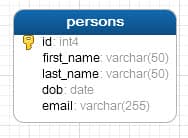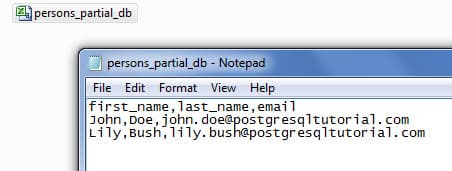Export PostgreSQL Table to CSV File
Summary: in this tutorial, you will learn various techniques to export data from PostgreSQL tables to CSV files.
In the previous tutorial, we showed you how to import data from a CSV file into a table. We will use the same persons table for importing data from a CSV file.
 The following statement retrieves the data from the
The following statement retrieves the data from the persons table.
SELECT * FROM persons;Output:
id | first_name | last_name | dob | email
----+------------+-----------+------------+---------------------------------
1 | John | Doe | 1995-01-05 | [[email protected]](../cdn-cgi/l/email-protection.html)
2 | Jane | Doe | 1995-02-05 | [[email protected]](../cdn-cgi/l/email-protection.html)
(2 rows)Export data from a table to CSV using the COPY statement
The COPY statement allows you to export data from a table to a CSV file.
For example, if you want to export the data of the persons table to a CSV file named persons_db.csv in the C:\temp folder, you can use the following statement:
COPY persons TO 'C:\temp\persons_db.csv' DELIMITER ',' CSV HEADER;Output:
COPY 2The output indicates that the command exported two rows.
In this example, the COPY statement exports all data from all columns of the persons table to the persons_db.csv file.
 Sometimes, you may want to export data from some columns of a table to a CSV file. To achieve this, you can specify the column names together with the table name after
Sometimes, you may want to export data from some columns of a table to a CSV file. To achieve this, you can specify the column names together with the table name after COPY keyword.
For example, the following statement exports data from the first_name, last_name, and email columns of the persons table to person_partial_db.csv
COPY persons(first_name,last_name,email)
TO 'C:\temp\persons_partial_db.csv' DELIMITER ',' CSV HEADER; If you don’t want to export the header, which contains the column names of the table, you can remove the
If you don’t want to export the header, which contains the column names of the table, you can remove the HEADER flag in the COPY statement.
For example, the following statement exports only data from the email column of the persons table to a CSV file:
COPY persons(email)
TO 'C:\temp\persons_email_db.csv' DELIMITER ',' CSV; Notice that the CSV file name that you specify in the
Notice that the CSV file name that you specify in the COPY command must be written directly by the server.
It means that the CSV file must reside on the database server machine, not your local machine. The CSV file also needs to be writable by the user that the PostgreSQL server runs as.
Export data from a table to a CSV file using the \copy command
If you have access to a remote PostgreSQL database server, but you don’t have sufficient privileges to write to a file on it, you can use the PostgreSQL built-in command \copy.
The \copy command runs the COPY statement behind the scenes. However, instead of the server writing the CSV file, psql writes the CSV file and transfers data from the server to your local file system.
To use \copy command, you need to have sufficient privileges to your local machine. It does not require PostgreSQL superuser privileges.
For example, if you want to export all data from the persons table into persons_client.csv file, you can execute the \copy command from the psql client as follows:
\copy (SELECT * FROM persons) to 'C:\temp\persons_client.csv' with csvIn this tutorial, we have shown you how to use COPY statement and \copy command to export data from a table to CSV files.